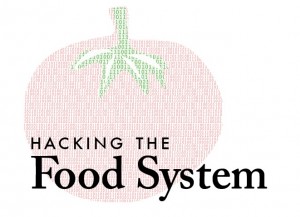[Hacking the Food System is an online conversation exploring how technology, information and data can change the food system status quo. Join the conversation below, on Twitter(hashtag #foodtech), or at out anniversary party.]
We can think about how to hack the food system through both pragmatic and applied innovation, and also through imaginative and critical engagements with agriculture and food. 
One of the questions I’m interested in is: How can sensing and robotics technologies support small-scale agriculture? There are many immediate answers, such as using sensor networks to monitor basic environmental conditions for small-scale farming or aquaponics. There are even some case studies of working deployments, such as the sensor network at Camalie Vineyards.
There’s real potential in the use of these technologies to aid farmers in decision-making and increase the resilience of their farms. The challenge is that we need
to fundamentally re-think and re-design agricultural technologies.
For the past century ag-tech has focused almost exclusively on industrial agriculture. There is scant research and development of ag-tech for small-scale scale agriculture. What we need to do is work together (designers and farmers) to invent new ag-tech. We also need to use information and communication technologies to create networks of ag-tech hackers.
Some of these networks are already emerging, such as the Young Farmer’s Coalition Farm Hack project and the community that has been created around window farms. These case studies of innovative technology development for small-scale agriculture and burgeoning communities of DIY ag-tech designers are inspiring.
In addition to applied innovation in ag-tech, we also need to create opportunities for public understanding and engagement with the issues of agriculture and food. This is where art and design, advocacy and aesthetics can meet in exciting ways. The Center For Genomic Gastronomy is a case in point. This independent organization produces accessible and enjoyable public projects that engage hefty issues such the use of genetically modified organisms as food products and the cultivation of “taste.” Another example is Natalie Jeremijenko’s , Cross(x)-Species Adventure Club. The club consists of constructed meals that express ecological issues through the design of the individual dishes.
Some of these projects use technology, other don’t. Regardless, they all have the potential to hack the food system by re-framing our discussions of food politics and bringing new audiences into those discussions.
As the features and interviews of Food + Tech Connect show, there’s a stunning range of work making use of information and technology to hack the food system. As these endeavors more forward, one question to consider is how might we better leverage information and technology to collaborate—to come together to work more collectively in transforming agriculture and food culture.
_____________________
Carl DiSalvo’s research explores the design of events, objects, and spaces that prompt creative and critical engagements with emerging technologies. Since 2007 he has been an assistant professor in the Digital Media Program at the Georgia Institute of Technology, where he established The Public Design Workshop to investigate the role of design in enabling public discourse and action. His current work is focused on participatory and speculative design for small-scale agriculture. He has a Ph.D. in Design from Carnegie Mellon University.
Related articles
- Carl DiSalvo on Hacking the Food System: Reinvent Ag-Tech (foodandtechconnect.com)
- Stefani Bardin on Hacking the Food System (foodandtechconnect.com)
- Marcus Samuelsson on Hacking the Food System: Taking Food to a Whole New Level (foodandtechconnect.com)
- Dickson Despommier on Hacking the Food System (foodandtechconnect.com)
- Ali Partovi on Hacking the Food System: Focus on the Supply Chain (foodandtechconnect.com)
- Joanne Wilson on Hacking the Food System (foodandtechconnect.com)
- Bill Niman on Hacking the Food System (foodandtechconnect.com)




